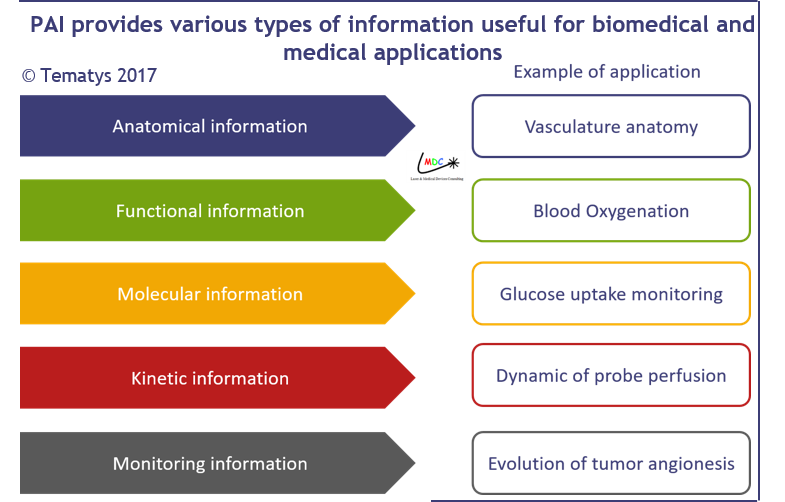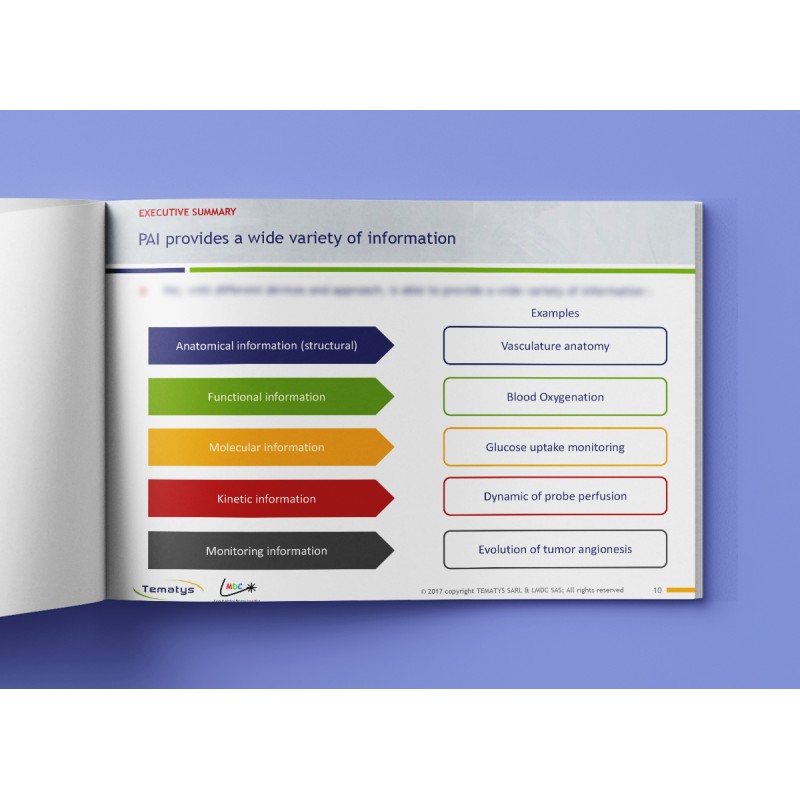Photoacoustic Imaging: Technology, Systems, Market and Trends (2017)
From Research Labs to Clinical Products
Objectives of the report
- Provide an overview of Photoacoustic Imaging components and systems on the market and under development,
- Define and analyze the different market segments of the PAI market,
- Identify PAI main industrial and R&D players worldwide,
- Provide a market forecast until 2022 for each application segment,
- Underline main challenges to be addressed both on technology side and application side in short, mid and long-term.
Report outline
- Title: Photoacoustic Imaging: Technology, Systems, Market and Trends.
- 250+ slides
- 3 990 € – Multi users license
Key Features of the report
- PAI components Overview: light sources, acoustic transducers, data processing and algorithms
- PAI systems technologies Overview: tomography, microscopy, handheld systems and endoscopy
- Markets Forecast and Trends for Components and R&D, Pre-clinical, Analytics and Clinical segments
- Key features of PAI for medical applications
- Requirements for market accessibility
- Market drivers and remaining challenges
- Products roadmap
- Patents Landscape
The PAI biomedical and medical market is expected to reach $ 240M in 2022!
Since the first images obtained in 2000, Photoacoustic Imaging has raised more and more interest for biomedical and medical applications. First applications were found in Research and Development. A lot of Proofs of Concept for in vitro and in vivo diagnostics and monitoring have been established.
Currently, PAI is spreading to biomedical and medical markets. The 3 main segments are: Pre-clinical (drug efficiency monitoring on small animal), Analytics (microscopy, flow cytometry for in vitro diagnosis), Clinical (early stage diagnosis).
In 2016, the total PAI biomedical and medical market was worth $ 35M, due to the Pre-clinical and Analytics segments only. It is forecasted to reach around $ 240M in 2022. A sharp increase is expected starting from 2018, due to the release of clinical products that are to be approved in 2017, like the « Imagio » system from Seno Medical Instruments, US (already CE marked, pending FDA approval). Within 4 to 5 years, the clinical market is expected to become the largest segment of the PAI biomedical and medical market, ahead of Pre-clinical applications. The main applications that will benefit from PAI clinical products are cancer diagnostic, cardiovascular diseases, dermatology, brain imaging, therapy monitoring and drug developments.
In the report, each segment of the PAI market (R&D, Pre-clinical, Analytics and Clinical) is analyzed in detail. Market forecasts and perspectives up to 2022 are provided. Main players are listed and detailed.

Photoacoustic imaging: a powerful combination of optical and acoustics technologies
In healthcare and life science, there is a huge demand for high resolution imaging at high penetration depth, in real time and at an affordable price. With an appropriate combination of optical and acoustical means, added to data processing and specific algorithms, Photoacoustic Imaging offers several advantages over other biomedical and medical imaging modalities:
-Safe and non-invasive: it is therefore adapted for repeated use on in vivo tissues, and is suited for treatment monitoring contrary to X-rays.
-Label-free: avoids the issue of approved labels in in vivo imaging.
-Speckle free: contrary to OCT and ultrasonography. It provides higher quality images.
-Scalable: PAI allows to image biological objects from organelles and cells to tissues or organs, while keeping the same high depth vs. resolution ratio.
-High penetration depth : up to several cm, allowing to image in 3D whole organs or whole body parts (like breast)
-Provides various types of information: anatomical, functional, molecular and kinetic information.
In view of all those assets, one can wonder whether PAI could replace other techniques like X-rays for various major imagery applications like breast cancer detection and screening.
The report provides an overview of optical and acoustic technologies forming a PAI system, as well as the trends in data processing and image reconstruction algorithms. It describes in details the main features of PAI, that makes it a powerful technique for clinical applications.

Towards the clinical use of PAI
Four implementations of PAI are possible, making it a tool that easily adapts to the clinical need : handheld PAI devices (HPAT) have been developed for point-of-care applications like dermatology or oncology diagnosis at the doctor’s office.
Endoscopes integrating PAI have been demonstrated for cardio-vascular imaging inside arteries. Photoacoustic Computed Tomography (PACT) allows 3D imaging of organs. PAI can also be implemented in a microscope (PAM) for in vitro or ex vivo diagnosis. PAI is thus expected to be adopted in various clinical applications. However, the access to the clinical market is long and complex.
One of the challenges is the acceptation of PAI by clinicians. To overcome this challenge, first clinical devices expected to be adopted are systems combining Ultra-sounds and PAI. Indeed, Ultrasonography (US) is a well-known and well-established technique. However, it provides only structural information. PAI brings functional information to US imaging. Moreover, the entry of PAI into clinical applications is going to be boosted by the growing number of companies - startups and large firms like Fujifilm or Canon - that are investing in this technology.
In the report, we point out the remaining challenges for clinical adoption of PAI, the issues to overcome to get a large imaging market share and a roadmap of the forthcoming clinical product.

Companies mentioned in the report
Acoustic Medsystems, Acousys Biodevices, Actuated Medical, Advanced Optowave, Alpinion Medical, Analogic Ultrasound, Blatek Industries, BK Medical, Cephasonics, Canon, Cobolt, Continuum, Crystalaser, CTS, Echofos, Echolase, Edgewave, Elforlight , Ekspla, Endra Life Science, Esaote, Fairway Medical Technologies, Fujifilm, G.E. Healthcare, Hitachi Aloka, Hitachi Medical, Hologic, IB Lasers, Illumisonics, Imasonic, Innolas, Innolume, IPG, Japan Probes, Jenoptics, Kolo, Kibero, Laser Export Co, LDX Optronics, Ligth Age, Litron, Lotis TII, Microscopic Photo Acoustics, Multiwave, Omicron, Opotek, OptoSonics, Panametrics, PA Imaging, Philips Research N.A., Koninklijke Philips N.V., Photonics Industries, Photosound, PolarOnyx, Precision Acoustic, Prexion, Prosonic, Quantel, Quanta system, S-Sharp, Samsung Medison, Schimadzu, Seno Medical Instruments, Siemens Healthcare, Sirah, Sonaxis, Sonic, Sonotec, Spectra Physics, Supersonic Imagine, Symphotics TII, Teem Photonics, Tomowave Laboratories, Ultrasonix, Verasonics, Vermon, Vibronix, VisualSonics, Xarion Laser Acoustics, Zonare
Table of content
Executive Summary
Photoacoustic Imaging Report
2. Highlights of the report
3. PAI, a powerful imaging modality
4. PAI technologies overview
5. Markets and Trends





